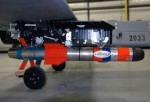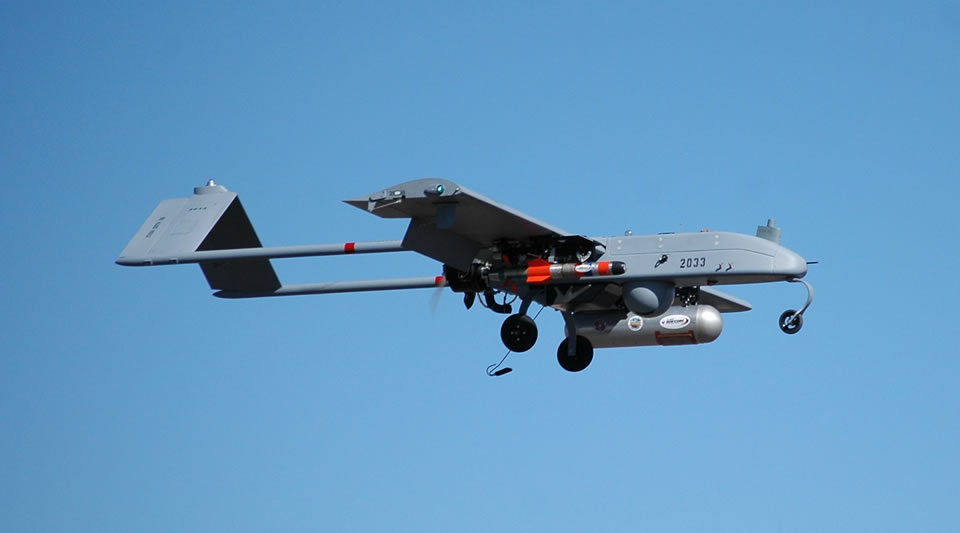

With the missions of Tactical Unmanned Aerial Systems (TUAS) evolving from pure reconnaissance into armed recce, targeting and selectively engaging targets at very short response cycles, the US Marine Corps and Army are looking for low cost, high precision and compact aerial weapons that could be delivered from TUAS in the most effective way without compromising mission performance. This requirement demanded the introduction of a new class of lightweight guided weapons. Several companies have already demonstrated such weapons. The most recent was Lockheed Martin that reported today on the successful first launch of the ‘Shadow Hawk’ precision-guided weapon from a Shadow 200 Unmanned Aircraft System (UAS), achieving a direct hit on the target.
The new guided munition is a five kilogram (11-pound) class, seven centimeter diameter (2.75-inch), 68 cm long (27-inch) drop-glide guided weapon that uses semi-active laser (SAL) seeker for terminal guidance. Shadow Hawk provides better than one meter precision and has effective off-axis capability, enabling engagement of designated targets off the aircraft’s wing. The weapon is equipped with an anti-personnel warhead optimized for the mission at hand and the TUAV platform class. Its low weight enables the Shadow UAS to maintain longer time-on-station for performing critical reconnaissance, surveillance and target acquisition operations.
The test was conducted at the UAS Rapid Integration and Acceptance Center, Dugway Proving Ground, Utah. The Shadow Hawk munition was released from the Shadow at an altitude of 5,100 feet and impacted the target at a speed of 460 feet per second. Shadow Hawk’s sensor package, guidance electronics and control section successfully navigated the weapon to the target, hitting it just eight inches off the laser spot center. For this initial demonstration, the target was designated with a ground location laser designator.
“As the mission of the Shadow UAS continues to evolve, it will need capability that can immediately neutralize threats detected and designated by the Shadow’s sensor package, with minimum impact to the aircraft’s endurance,” explained Glenn Kuller, director of advanced programs in Lockheed Martin’s Missiles and Fire Control business. “With precision strike accuracy, the Shadow Hawk is an ideal solution in urban environments where low collateral damage is essential.” Kuller added: “Equipped with Shadow Hawk and the UAS’ electro-optical and infrared cameras, a Shadow UAS can now offer battlefield commanders timely detection of threat activities, including fleeting and time-sensitive threats, along with a quick-strike capability,” Kuller said. “All of Shadow Hawk’s seeker and guidance components are flight proven and production ready, having been developed and tested on other Lockheed Martin weapon systems.”

Two years ago Lockheed Martin conducted another small weapon in a similar test profile. The Scorpion was about twice the size of the current Shadow Hawk. Back then the ‘Scorpion’ was launched from a C-130 aircraft at Yuma Proving Ground, AZ., probably as part of the evaluation of weapon alternatives for the Marine Corps’ KC-130J Harvest Hawk program. (Eventually, the Raytheon Griffin and MBDA Viper Strike were selected for Harvest Hawk). The Scorpion was ejected at an altitude of 5,000 feet through a Common Launch Tube (CLT) carried on the aircraft, successfully deployed its fins and wing, allowing it to precisely glide 1.65 nautical miles to the target. This weapon was designed to glide and hit targets at a maximum range of over 10 nautical miles. At that time the company said the Scorpion is adaptable to multiple launch platforms, including manned and unmanned systems. Scorpion was also said as being able to mount various seekers, including SAL, imaging infrared, shortwave infrared or millimeter wave seekers. The typical targets attributed to the Scorpion were described as structures, personnel, lightly armored vehicles, trucks, cars, missile launchers, and artillery or gun positions. Both weapons are based on elements developed for the 2.75″/70mm DAGR laser guided rocket, also developed by Lockheed Martin Missiles & Fire Control Systems.
Other companies that have demonstrated similar compact, lightweight precision attack munitions for UAVs include Raytheon, ATK and DRS Technologies. Among these systems the Small Tactical Munition II from raytheon weighs about 13.5 pounds. Raytheon proposes stacking two such miniature guided weapons carried in tandem in a CLT. The Shadow could take a total of four such weapons, or only two, in an asymmetric configuration. providing more fuel for extended endurance. Another weapon developed by ATK is the Hatchet. It is even smaller, each weighing about four pounds. ATK designed a specialized pylon for the Shadow, also carrying two Hatchets. ATK has also configured special ejector racks and rotary launchers carrying multiple Hatchets, enabling a MQ-5B Hunter or MQ-1A Predator UAVs to carry 24 weapons while the MQ-9A Reaper could carry 72 while the MQ-18 A-16T Hummingbird would be able to mass 200 Hatchets. The Naval Air Warfare Center, Weapons Division (NAWCWD) and DRS Technologies have also developed the Spike missile, fitted with Semi-Active laser seeker, which would also be capable of deploying on tactical UAS.

















